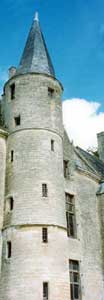

Côtes d'Armor |
Finistère |
Ille et Vilaine |
- Châteaugiron
- Combourg
- Fougères
- Hédé
- Landal
- Montmuran
- Saint Aubin
- Vitré
Morbihan |
Other regions & other castles |
Previous months’ selections |
| Castle of Hac |
|
|
The door opens on the low room with the top of which two other rooms are. That of in top, partially arranged under the roof and lit by attic windows, contains the private vault, placed in a back tower. On right-hand side of the entry, each stage has two parts. One of those of bottom always was undoubtedly used as kitchen. The other, built above a cellar with half buried, is the room of the lord, and comprises a small opening by which this one can observe the activity of the large low room. These installations are common in the Breton manors. All the parts have elegant chimneys. The room low, roomy, has superb and was equipped with beams and moulded beams. In all the parts, the chimneys are elegant. The higher room, arched in cradle, obeys a fashion style in the medieval residences of the same importance. With the castle of Hac, this frame, restored in 1684, is a testimony of the medieval time. The Eastern part of the current building which comprises a kitchen and two parts above, was probably a residential tower having survived a construction of the medium of XVe century. Hac illustrates two of the most persistent characteristics of French architecture seigneuriale: Superimposed rooms and the incorporation of older rooms. Text extracts from the book "To like the Castles of Brittany" of Gwyn Meirion Jones and Michael Jones. |
|
Castle of the month : |
Search |
For any question concerning this Web site, send a message to webmaster

 One
of the most beautiful large manors, the castle of Hac occupies a
traditional site seigneurial, between formerly arable fields and
the meadow. Under its current aspect the building, which goes back
to 1440-1448, was the center of a significant agricultural field
and the residence of countryside of the Hingant family whose Jean
Hingant, chamberlain of the duke, lost the property in 1450. The
castle of Hac testifies to a family powerful, refined "go-getter"
and considerably rich person.
One
of the most beautiful large manors, the castle of Hac occupies a
traditional site seigneurial, between formerly arable fields and
the meadow. Under its current aspect the building, which goes back
to 1440-1448, was the center of a significant agricultural field
and the residence of countryside of the Hingant family whose Jean
Hingant, chamberlain of the duke, lost the property in 1450. The
castle of Hac testifies to a family powerful, refined "go-getter"
and considerably rich person. 
